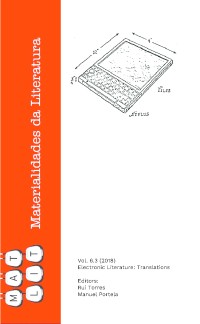Please use this identifier to cite or link to this item:
https://hdl.handle.net/10316.2/44381| DC Field | Value | Language |
|---|---|---|
| dc.contributor.author | Marques, Ana | - |
| dc.date.accessioned | 2018-10-24T09:59:28Z | |
| dc.date.accessioned | 2020-10-04T00:49:40Z | - |
| dc.date.available | 2018-10-24T09:59:28Z | |
| dc.date.available | 2020-10-04T00:49:40Z | - |
| dc.date.issued | 2018 | - |
| dc.identifier.issn | 2182-8830 | - |
| dc.identifier.uri | https://hdl.handle.net/10316.2/44381 | - |
| dc.description.abstract | Um texto generativo é um sistema constituído por cognitores inconscientes e conscientes, processos digitais e analógicos, e modos matemáticos e linguísticos de representação. Mas em que consiste a cognição algorítmica? E de que modo é construído o sentido num sistema em que as intenções autorais e as experiências e interpretações dos leitores são mediadas por agentes algorítmicos? Através da análise de How It Is In Common Tongues (Cayley and Howe, 2012), pretendo analisar as tensões que surgem a partir do encontro entre cognição algorítmica e humana, e entre regimes de informação e de expressão. Com base na visão de Katherine Hayles sobre cognição não-consciente e na teoria de informação de Claude Shannon, começo por estabelecer uma distinção entre informação e sentido, entre comunicação e expressão, e entre os regimes de informação e o literário. Para refletir sobre a ecologia política da mediação digital (situada no regime informacional da cibernética), considerarei a perspetiva de Matteo Pasquinelli sobre a coevolução da tecnologia e da economia, e considerarei como os processos cognitivos algorítmicos incorporam e reforçam as estruturas do capitalismo cognitivo contemporâneo. Por fim, referirei as estratégias de resistência possibilitadas pelas abordagens estéticas da computação, como as que são exploradas neste estudo de caso. | por |
| dc.description.abstract | A generative text is a system constituted by non-conscious and conscious cognizers, digital and analogue processes, and mathematical and linguistic modes of representation. But how do algorithms cognize? And how is meaning constructed in a system where authorial intentions and readers’ experiences and interpretations are mediated by algorithmic agents? Through the analysis of How It Is In Common Tongues (Cayley and Howe, 2012), I intend to discuss the tensions that arise from the encounter between algorithmic and human cognition, and between the regimes of information and expression. Drawing on Katherine Hayles’ view on the cognitive non-conscious and Claude Shannon’s information theory I will start by establishing a distinction between information and meaning, between communication and expression, and between the regimes of information and of the literary. To reflect on the political ecology of digital mediation (situated in the informational regime of cybernetics), I will consider Matteo Pasquinelli’s perspective on the co-evolution of technology and economics, and discuss how algorithmic cognitive processes embody and reinforce the structures of contemporary cognitive capitalism. Finally, I will discuss the strategies of resistance enabled by aesthetic approaches to computation, such as the ones explored in this case study. | eng |
| dc.language.iso | eng | - |
| dc.publisher | Centro de Literatura Portuguesa | - |
| dc.publisher | Imprensa da Universidade de Coimbra | - |
| dc.rights | open access | - |
| dc.subject | cybernetics | eng |
| dc.subject | cognition | eng |
| dc.subject | information | eng |
| dc.subject | meaning | eng |
| dc.subject | aesthetics | eng |
| dc.subject | cibernética | por |
| dc.subject | cognição | por |
| dc.subject | informação | por |
| dc.subject | sentido | por |
| dc.subject | estética | por |
| dc.title | Writing with automated machines: between translation and sabotage | por |
| dc.type | article | - |
| uc.publication.collection | Matlit v. 6, nº 3 | - |
| uc.publication.firstPage | 73 | - |
| uc.publication.issue | 3 | - |
| uc.publication.lastPage | 81 | - |
| uc.publication.location | Coimbra | - |
| uc.publication.journalTitle | MATLIT: Materialidades da Literatura | - |
| uc.publication.volume | 6 | por |
| dc.identifier.doi | 10.14195/2182-8830_6-3_6 | - |
| uc.publication.orderno | 6 | - |
| uc.publication.area | Artes e Humanidades | - |
| uc.publication.manifest | https://dl.uc.pt/json/iiif/10316.2/44381/263700/manifest?manifest=/json/iiif/10316.2/44381/263700/manifest | - |
| uc.publication.thumbnail | https://dl.uc.pt/retrieve/12074556 | - |
| item.grantfulltext | open | - |
| item.fulltext | With Fulltext | - |
| Appears in Collections: | Matlit | |
Files in This Item:
| File | Description | Size | Format | |
|---|---|---|---|---|
| writing_with_automated_machines.pdf | 781.2 kB | Adobe PDF |  |
Items in DSpace are protected by copyright, with all rights reserved, unless otherwise indicated.
